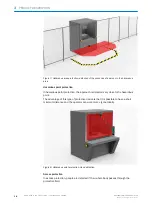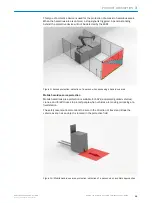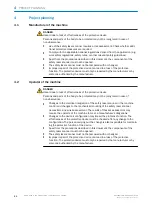
•
Type of approach: parallel
•
Parameters specified based on the application
•
Supplements for general and, possibly, reflection-based measurement errors
•
Supplement to protect against reaching over
•
Height of the scan plane
•
Switching time between monitoring cases
Important information
NOTE
More information is available in the ISO
13855 standard and in the Guide for Safe
Machinery.
NOTE
SICK offers a stopping/run-down time measurement service in many countries.
Calculation example of the minimum distance S according to ISO 13855
The example shows the calculation of the minimum distance for parallel approach
to the protective field. Depending on the application and the ambient conditions a
different calculation may be required. (e.g., a protective field or at an arbitrary angle to
the direction of approach or an indirect approach)
b
Calculate S using the following formula:
S = 1600 mm/s × T + TZ + Z
R
+ C
where:
°
S = minimum distance in millimeters (mm)
°
T = stopping/run-down time for the entire system in seconds (s)
(Response time of the safety laser s machine’s stopping/run-down
time, incl. response time of the machine’s control system and signal propaga‐
tion time)
°
TZ = tolerance range of the safety laser scanner,
°
Z
R
= supplement for reflection-based measurement errors in millimeters
(mm)
°
C = supplement to protect against reaching over in millimeters (mm)
The reach/approach speed is already included in the formula.
Supplement Z
R
for reflection-based measurement errors
All devices: If there is a retroreflector in the vicinity of the protective device (distance
of the retroreflector from protective field ≤ 6 m), you must take the supplement Z
R
=
350 mm into account.
Devices with max. protective field range of 9 m for stationary applications: Strongly
reflective surfaces (e.g. shiny metal, tile) with a distance from the protective field ≤ 6 m
can behave similarly to a retroreflector if the laser beam hits the surface vertically. If
the protective field is larger than 50% of the protective field range in the direction of
the laser beam which is hitting the surface vertically, you must take supplement Z
R
=
350 mm into account in this direction.
3)
Supplement Z
R
must be upheld at least at a
width of 3 × d (d = set object resolution) around the laser beam which hits the surface
vertically.
Supplement C to protect against reaching over
Under certain circumstances, a person can reach the hazardous area by reaching over,
before the protective device stops the dangerous state. Supplement C prevents this.
3)
The protective field range depends on the set scan cycle time and resolution.
4
PROJECT PLANNING
30
O P E R A T I N G I N S T R U C T I O N S | microScan3 Core I/O AIDA
8017784/1ELL/2022-01-21 | SICK
Subject to change without notice
















































